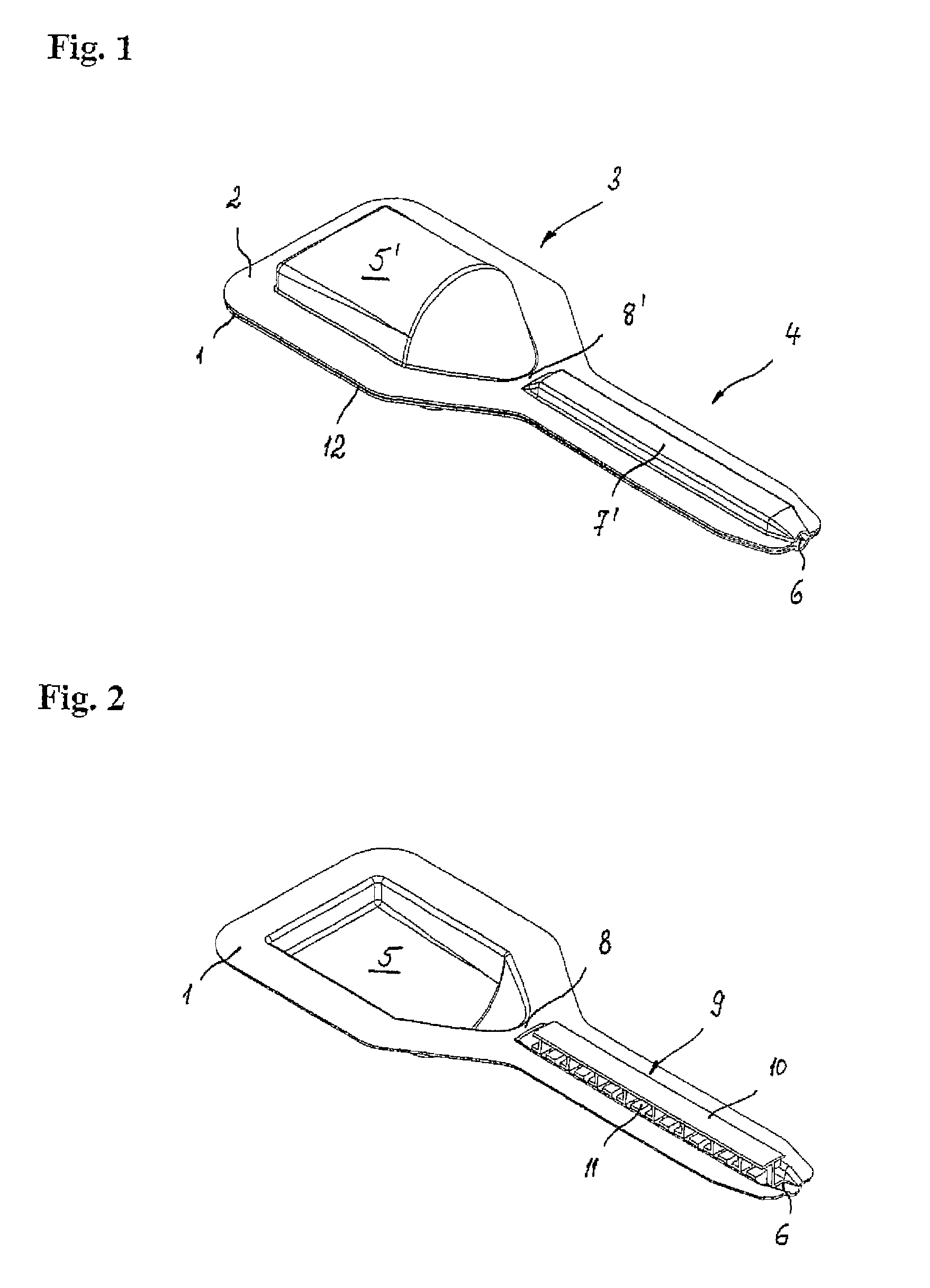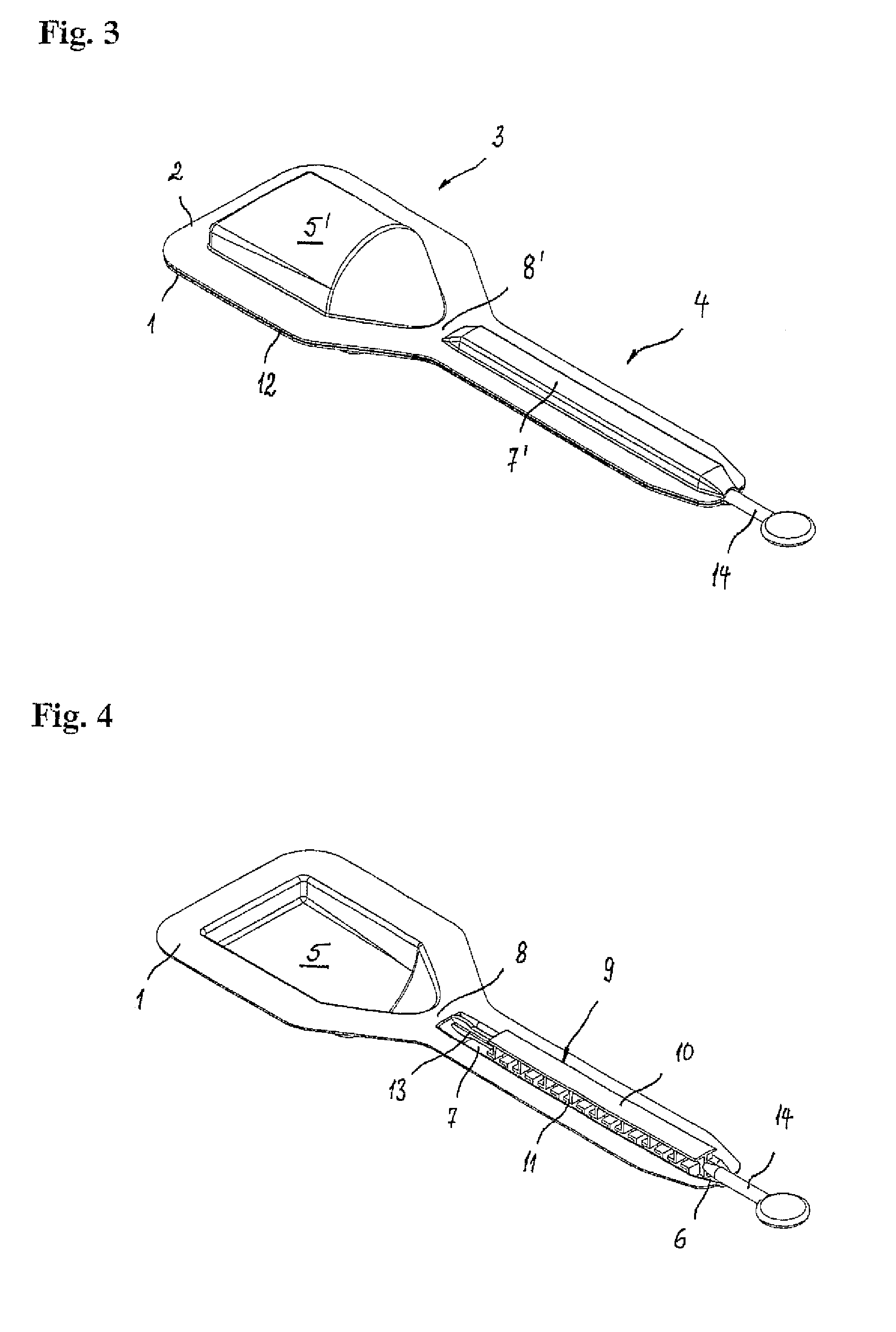Multicomponent foil-type container
a multi-component, foil-type technology, applied in the direction of pliable tubular containers, packaging goods types, transportation and packaging, etc., can solve the problems of large mixing volume, high squeezing resistance, and inability to modify without additional means, etc., to achieve convenient opening, simple deflection elements, and efficient mixing
- Summary
- Abstract
- Description
- Claims
- Application Information
AI Technical Summary
Benefits of technology
Problems solved by technology
Method used
Image
Examples
third embodiment
[0057]The third embodiment shown in FIGS. 5 and 6 differs from the previously mentioned constructions essentially in that the groove-shaped indentations 7 and 7′ have inclined parts 15 and 15′, respectively, elongated on the chamber-side end and arranged next to an area 16 and 16′ of the chambers 5 and 5′, respectively, elongated towards the front. As follows from FIG. 6, the inclined part 15 of the indentation 7 and the chamber 5 are arranged one next to the other with its elongated area 16 so that the inclined parts 15 and 15′ of one hall-shell each overlap the elongated areas 16 and 16′ of the other half-shell when the identical half-shells 1 and 2 are placed one on top of the other. Opening pins 17 and 17′, which can be pressed from the outside, which project inwards, and which can be made to pierce through the separating film or films 12 arranged between the half-shells 1 and 2 by hand without damaging the outer skin of the container, are arranged on the two inclined parts 15 a...
fourth embodiment
[0058]In the fourth embodiment shown in FIGS. 7 and 8, a separate discharge tube 18 with the discharge duct 6 arranged therein is provided. The discharge tube 18 can be set on a separate storage part 19 of the multicomponent foil type container at this point. The storage part 19 is here composed of two identical half-shells 1 and 2, in which the chambers 5 and 5′ formed by bulges are located. The two chambers 5 and 5′ are also here filled with different components. The seal is realized here by a separating film 12 arranged between the half-shells 1 and 2 and by a front separating wall 21 of the half-shells 1 and 2. The chambers 5 and 5′ are separated from the discharge duct 6 of the discharge tube 18 before use by the front separating walls 21 of the two half-shells 1 and 2. The discharge tube 18 can be connected to the storage part 19 sealed from the outside by means of a sleeve-shaped attachment part 20. To connect the chambers 5 and 5′ to the discharge duct 6, the separating wall...
fifth embodiment
[0059]In the fifth embodiment shown in FIGS. 9 and 10, a discharge tube 23 is attached to a storage part 24 displaceable in the longitudinal direction. The storage part 24 is composed, in turn, from two identical half-shells 1 and 2, in which the chambers 5 and 5′ formed from indentations are constructed. Here, the two chambers 5 and 5′ are also separated from each other by a separating film or films 12 arranged between the half-shells 1 and 2. Within the half-shells 1 and 2 there are separating walls 25 and 25′, which prevent the discharge of the components into the discharge duct 6 before use. The discharge tube 23 is constructed for this configuration such that the mixing element 9 can be inserted from the discharge opening into the discharge duct 6.
[0060]As shown in FIG. 10, the discharge tube 23 is attached by means of a hollow cylindrical attachment piece 26 onto a throat 27 of the storage pan 24 with a round cross section displaceable in the longitudinal direction. The axial ...
PUM
 Login to View More
Login to View More Abstract
Description
Claims
Application Information
 Login to View More
Login to View More - R&D
- Intellectual Property
- Life Sciences
- Materials
- Tech Scout
- Unparalleled Data Quality
- Higher Quality Content
- 60% Fewer Hallucinations
Browse by: Latest US Patents, China's latest patents, Technical Efficacy Thesaurus, Application Domain, Technology Topic, Popular Technical Reports.
© 2025 PatSnap. All rights reserved.Legal|Privacy policy|Modern Slavery Act Transparency Statement|Sitemap|About US| Contact US: help@patsnap.com



